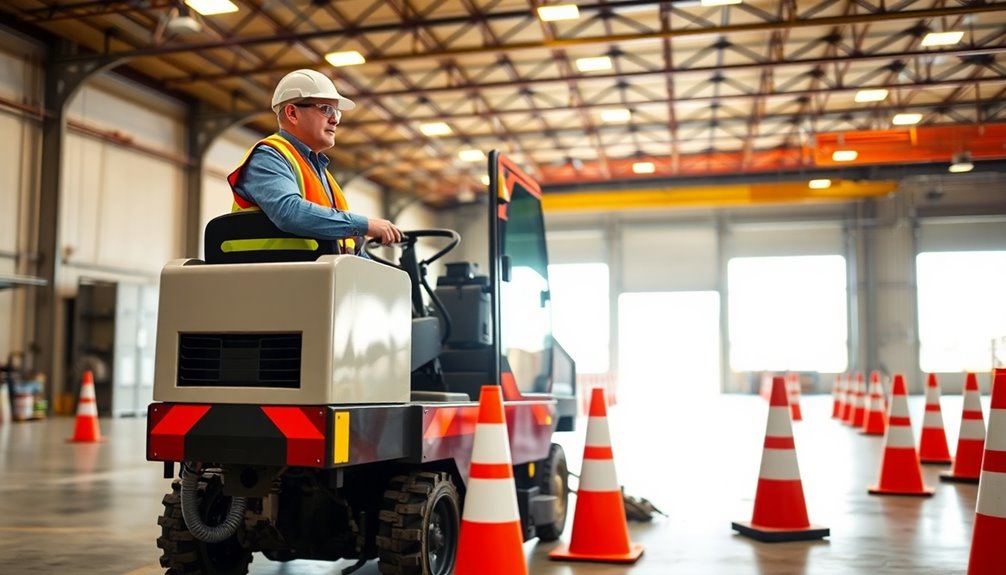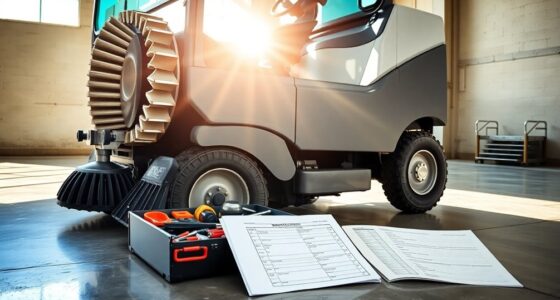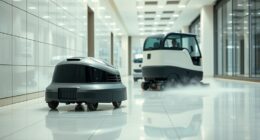To operate industrial sweepers safely, start with pre-operation checks like inspecting fuel levels and clearing debris. Always wear essential PPE, including safety glasses and gloves. Stick to recommended speeds and monitor your surroundings for obstacles. Regularly maintain your equipment and manage hazardous materials correctly. Training's crucial for understanding safety protocols, so keep your skills sharp. There's more you can do to enhance your safety practices and ensure a secure working environment.
Key Takeaways
- Conduct thorough pre-operation checks to ensure the sweeper is functioning properly and free of debris or damage.
- Always wear appropriate personal protective equipment (PPE) such as safety glasses, gloves, and hearing protection during operation.
- Maintain awareness of your surroundings, including weather conditions and potential obstacles, to prevent accidents.
- Follow recommended operational procedures and speed limits to enhance safety and control while operating the sweeper.
- Engage in regular training and practical evaluations to stay updated on safety protocols and proper equipment handling.
Pre-Operation Checks for Industrial Sweepers

Before you operate an industrial sweeper, it's crucial to conduct thorough pre-operation checks to ensure safety and efficiency.
First, check the fuel level or battery charge to guarantee you have enough power for the job. Don't forget to empty and clean the dust container regularly.
Inspect the main brushes for any debris or damage and verify that all lights are functioning properly. Confirm that the steering and brakes operate correctly for optimal control. Additionally, check the hydraulic fluid, engine oil, and coolant levels. Ensure that all electrical systems, including warning alarms, are operational. It's also important to check belts and adjust if necessary.
Finally, assess the environment for any potential hazards and remove debris that could interfere with the sweeper's operation.
Essential Personal Protective Equipment (PPE)

Operating an industrial sweeper requires more than just equipment checks; it also demands proper personal protective equipment (PPE) to ensure your safety on the job.
Start with safety glasses to shield your eyes from debris and chemical splashes. In noisy environments, wear hearing protection to guard against the sounds of gasoline or diesel engines. Regular monitoring of noise levels is essential to determine the need for hearing protection.
Face masks and respiratory protection are crucial when dealing with dust or harmful fumes from chemicals. Don't forget gloves to protect your hands while handling chemicals and maintaining machinery.
Depending on your tasks, consider additional gear like steel-toed boots for foot protection, high-visibility vests for low-light areas, and face shields for comprehensive coverage against splashes and debris.
Your safety depends on it!
Key Operational Safety Tips
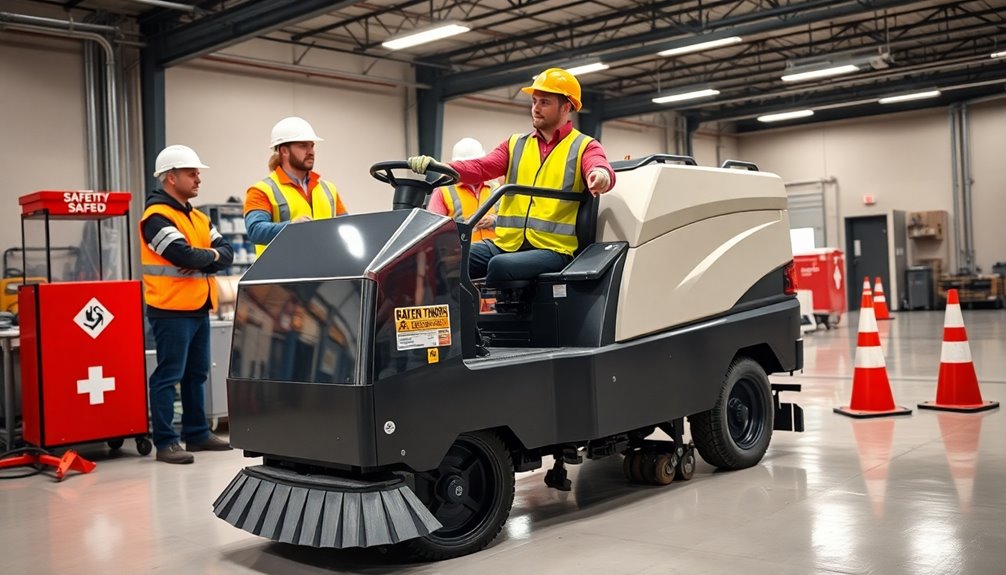
Five key operational safety tips can help ensure a smooth and secure experience when using industrial sweepers.
First, conduct a thorough machine inspection before you start—check for any issues and ensure all safety features are operational. Regular equipment maintenance is crucial to prevent accidents and ensure all components are functioning correctly.
Next, always keep an eye on weather conditions, as they can affect both visibility and surface traction.
Clear the area of obstacles to avoid potential hazards as you sweep.
During operation, maintain recommended speeds and be mindful of bystanders using mirrors or rearview cameras.
Lastly, understand how the load in the hopper impacts stopping distance, especially on wet or slippery surfaces.
Maintenance and Servicing Procedures

Regular maintenance and servicing are crucial for keeping industrial sweepers in optimal working condition. Establish a routine inspection schedule to check for wear and tear on all parts. Ensure the scrubbing head skirt condition is assessed regularly to maintain cleaning effectiveness. After each use, empty debris from the hopper and clean or replace filters to ensure proper airflow. Keep replacement parts on hand for quick fixes. Always follow lock-out procedures to safely shut down the machine before maintenance.
Regularly check broom bristles, hoses, and squeegees for damage. Lubricate moving parts to reduce friction and wear, and don't forget to update software for advanced systems. Maintain a detailed log of all maintenance activities for future reference, and ensure operators are trained in proper techniques and safety equipment.
Environmental and Health Considerations

While maintaining industrial sweepers, it's essential to consider their environmental and health impacts.
Using ride-on sweepers can significantly reduce water consumption, thanks to dust suppression systems that minimize cleaning water needs. You'll also benefit from chemical-free cleaning, protecting soil and water quality by avoiding harmful runoff. Additionally, these sweepers promote water conservation through their effective cleaning operations.
Efficient debris collection keeps pollutants from entering air or water bodies, contributing to cleaner surroundings. Moreover, modern sweepers are energy-efficient, helping lower greenhouse gas emissions.
On the health front, these machines help reduce air pollution by minimizing VOCs and particulate matter emissions.
Importance of Regulatory Compliance

Ensuring regulatory compliance in industrial cleaning is crucial, as it not only protects your business but also the environment and public health. You must navigate numerous regulations regarding chemical handling, storage, and disposal. Keeping up with these ever-changing laws can be challenging, but non-compliance can lead to hefty fines, legal penalties, and damage to your reputation. Accurate documentation, including chemical inventories and safety data sheets, is vital for proving compliance efforts. Implementing proactive compliance management strategies helps mitigate risks, ensuring a safer workplace. Regular employee training on safety protocols and regulatory updates will keep your team informed and compliant. By prioritizing regulatory compliance, you safeguard your business and contribute to a healthier environment. Ongoing training and education for employees is essential to maintain adherence to the latest regulations.
Effective Dust Suppression Techniques
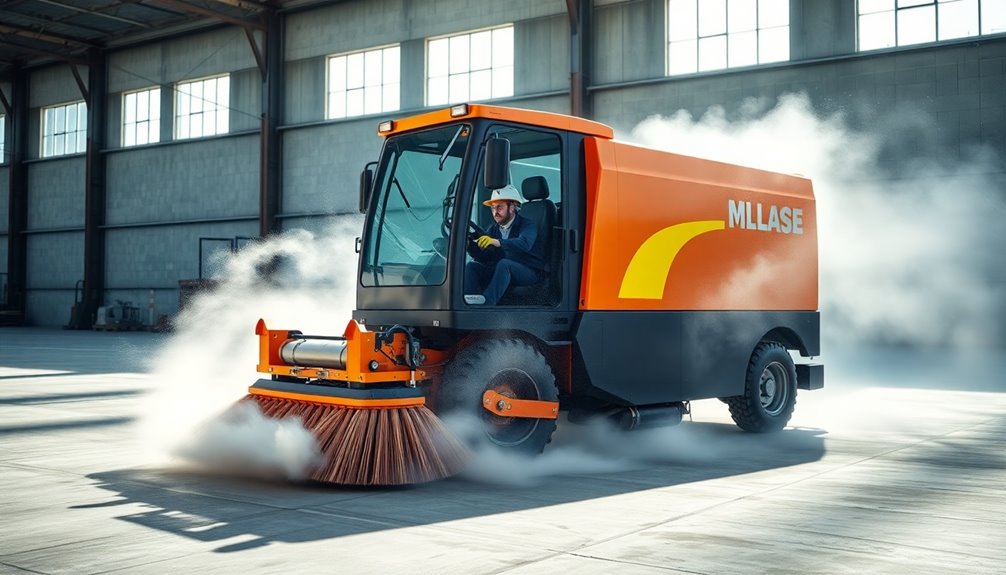
Effective dust suppression techniques play a vital role in maintaining a safe and clean work environment across various industries.
Using dust suppression systems, you can effectively prevent dust from becoming airborne, enhancing safety and reducing respiratory risks.
Wet sweeping methods, where you spray water onto surfaces, trap dust and debris, making your cleaning efforts more effective. Wearing appropriate personal protective equipment (PPE) while performing these tasks is crucial to ensure your safety from any potential hazards.
If wet methods aren't feasible, consider dry dust suppression, which utilizes specialized chemicals to keep particles grounded.
For advanced control, high-pressure systems like Dynaset HPW DUST provide a water fog that minimizes surface wetness.
Additionally, using HEPA sweepers ensures efficient dust capture, improving air quality and helping you stay compliant with OSHA standards.
Implementing these techniques can significantly enhance your work environment.
Proper Handling of Hazardous Materials

When handling hazardous materials, it's crucial to recognize the risks involved and take appropriate measures to mitigate them.
Start by implementing clear procedures for storing, transporting, and disposing of these materials. Always use personal protective equipment (PPE), like gloves and goggles, to safeguard your health. Regular audits ensure that safety protocols are consistently followed, while specialized training equips you to identify hazards and respond to emergencies effectively. Remember that improper handling can lead to respiratory issues, chemical spills, and environmental damage. Moreover, adhering to a clean workspace helps minimize risks associated with hazardous materials.
Lastly, adhere to safety regulations to minimize risks and maintain a safe workplace.
Training and Education for Operators
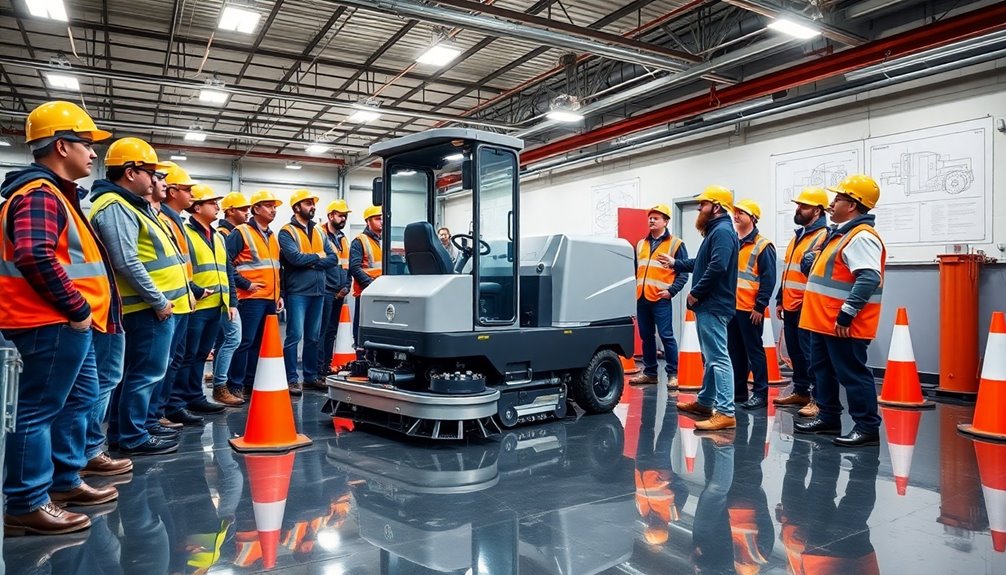
To operate industrial sweepers safely, you'll need comprehensive training and education tailored to the specific equipment and environment.
Most training programs align with OSHA standards, covering essential topics like equipment anatomy, safe operation, and common hazards. Typically, these courses last between 60 to 90 minutes and often include interactive elements such as quizzes and videos to enhance your learning. Additionally, immediate online access to your certificate of completion is provided upon passing the final exam.
Practical evaluations, while not always required, are recommended to ensure you grasp safety protocols. Upon completion, you'll receive a certificate, verifying your proficiency.
Employers should supervise practical evaluations and maintain accurate training records. Continuous learning is vital, so stay updated on evolving safety practices to ensure a safe working environment for everyone.
Frequently Asked Questions
What Are the Common Causes of Industrial Sweeper Accidents?
Common causes of industrial sweeper accidents include lack of proper maintenance, inadequate training, and environmental factors like traffic and poor visibility.
You might face issues from malfunctioning components or clogged filters, which can lead to unsafe conditions.
Speeding or sharp turns can increase rollover risks, while distractions can slow your reaction times.
Ignoring safety protocols or operating in cluttered or uneven environments also heightens the chances of accidents.
Always stay vigilant to minimize risks.
How Often Should Industrial Sweepers Be Inspected?
You should inspect industrial sweepers daily to catch any issues early.
Conduct a thorough visual check, focusing on brushes, filters, and safety lights. Additionally, schedule more in-depth servicing at regular intervals to maintain optimal performance.
Customize your checklist based on the sweeper's make and model, and ensure you sign off on inspections for accountability.
A supervisor should review these reports to keep everything in check and ensure efficient operation.
What Should I Do in Case of an Emergency?
In an emergency, think of yourself as a captain navigating through stormy seas. You need to stay calm and act swiftly.
First, assess the situation and alert others. Activate emergency contacts and follow established protocols.
Familiarize yourself with evacuation routes and assembly points. If necessary, use safety equipment responsibly.
Always communicate clearly with your team. Remember, your quick thinking and preparedness can steer everyone towards safety, ensuring no one gets left behind.
Can Weather Conditions Affect Sweeper Operation Safety?
Yes, weather conditions can significantly affect sweeper operation safety.
For instance, snow and ice can create slippery surfaces, increasing the risk of accidents. Wet conditions may make debris harder to remove, requiring more caution. High winds can blow debris back onto the streets, complicating your task.
Extreme temperatures can also impact equipment performance, so you'll need to adapt your approach and ensure your sweeper is properly equipped for the weather you're facing.
How Can I Improve Visibility While Operating a Sweeper?
To improve visibility while operating a sweeper, make sure your lighting systems are functioning properly and clean from ice or snow buildup.
Adjust your lights based on environmental conditions, and always maintain eye contact with other operators.
Use hand signals when visibility is limited, and stay aware of your surroundings.
Lastly, report any visibility issues to management promptly so they can address potential hazards effectively.
Conclusion
In the world of industrial sweeping, safety isn't just a guideline; it's your shield against potential hazards. By following proper checks, wearing the right PPE, and staying compliant, you're not just protecting yourself—you're ensuring a smooth operation. Think of your safety measures as a sturdy fence around a flourishing garden, keeping dangers at bay while allowing productivity to thrive. Remember, a well-trained operator is the backbone of a safe and efficient workspace. Stay vigilant, and keep safety first!
